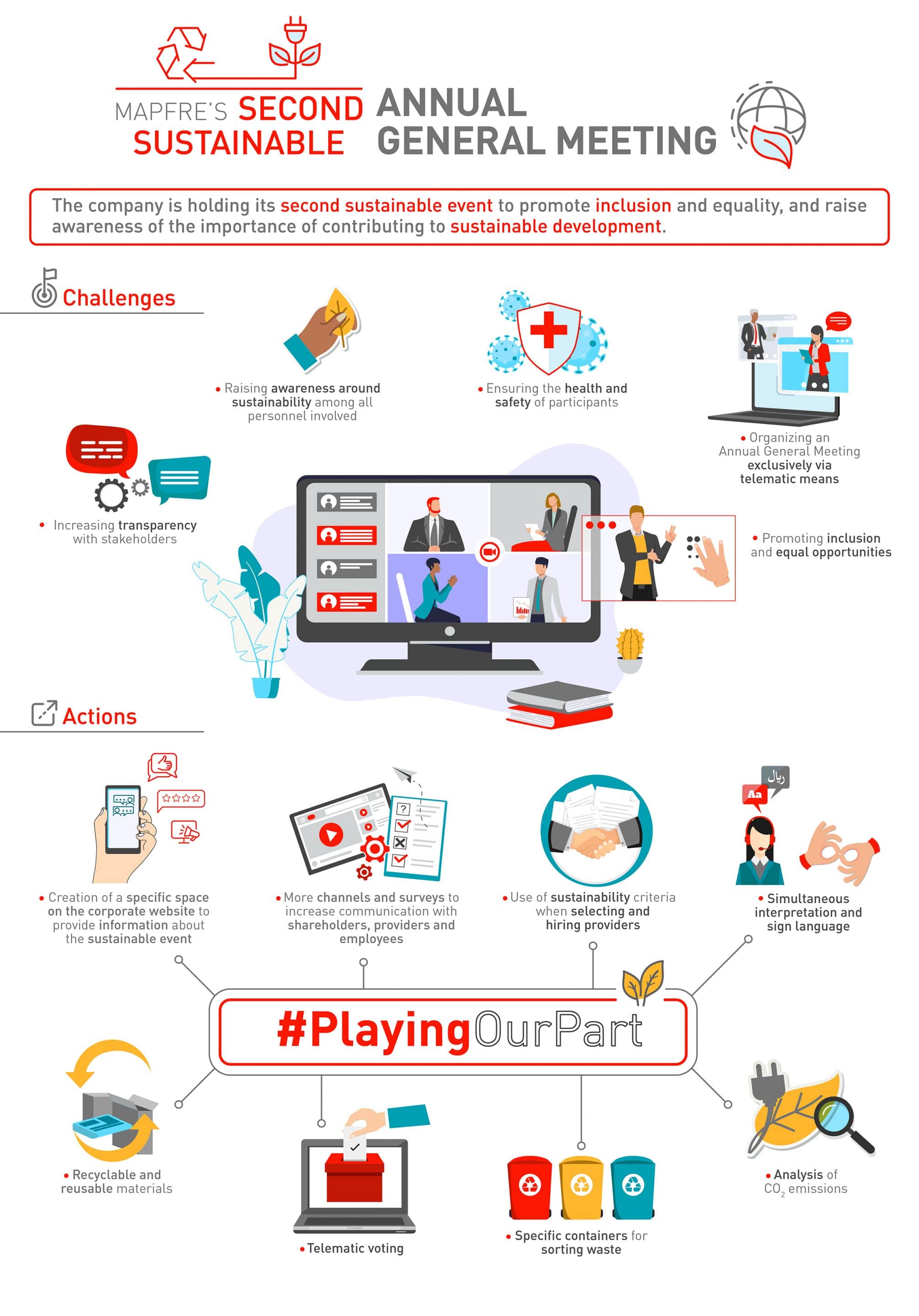SUSTAINABILITY| 11.03.2021
How and why should sustainable events be organized?
Green events offer thousands of benefits and are clear contributors to sustainable development. Not only do they help to cut CO2 emissions, they also promote equal opportunities, inclusion and local economies.
A sustainable event is, according to the United Nations, one designed and organized to meet two objectives: to minimize all potential negative impacts on the environment and leave a beneficial legacy for the host community and all involved.
Organizing a sustainable event represents a responsible act in terms of the environment and individuals. Companies opting for this type of event, like MAPFRE, demonstrate a firm commitment to equal opportunities, inclusion, and the protection of the environment. They also contribute to strengthening transparency and view stakeholders as relevant actors.
It’s a task that requires significant planning and coordination to meet specific goals and actions that are assessed regularly and ultimately verified through the authorized agencies.
Environmental impact
Sustainable events can minimize much of their environmental impact. This reduces the amount of waste generated (SDGs 11 and 13) and ensures proper waste management; reduces water and electricity consumption (SDG 12); and mitigates air, noise and light pollution (SDG 7). In these types of events, spaces that have natural light and clean air are also important; safe, healthy and sustainable mobility (SDG 11) is encouraged, for example, through the use of public and shared transport; and the catering companies chosen are required to avoid packaging, use reusable tableware and dishes, prioritize the use of bulk dispensers and jars for food and beverages and promote local, seasonal produce that is organic or Fair Trade.
Reducing CO2 emissions is also a plus. Many sustainable events are in turn carbon neutral, which means they take account of those emissions that couldn’t be avoided during the event. To this end, many companies calculate these CO2 emissions with a view to offsetting them by acquiring voluntary carbon credits from a project that is environmentally, socially and economically advantageous, thus achieving net zero emissions. MAPFRE, for example, has analyzed and offset the emissions for its last two annual general meetings. In 2020, for example, it calculated its carbon footprint and offset the tons of CO2 emitted through a project that provided renewable electric power through the construction of three small hydro plants installed in Brazil, one of the countries where the company operates.
Inclusion and equality
Sustainable events are also concerned with leaving a positive legacy for the community. To this end, they promote inclusion and equal opportunities (by hiring the same proportion of men and women and by simultaneously translating them into sign language (SDGs 5, 8, 10 and 16). They also encourage barrier-free access for persons with reduced mobility (SDG 10) and boost the local economy by hiring local businesses. (SDG 8)
Raising awareness
Strengthening communication and transparency with interest groups and raising awareness about these types of initiatives are key requirements from the outset. This involves communicating with stakeholders, such as shareholders, suppliers and employees in a proactive way and through various channels, such as the corporate website, for example, to provide them with information about the sustainable event, as well as learning, through surveys, what they expect from a meeting of this kind and why. Obtaining feedback is essential for planning sensibly and not leaving anyone behind.
Communication also plays a key role, as a sustainable event involves effort and commitment that should be shared with society. According to experts, it is very important that the companies that organize this type of event and meetings convey these values to the people who attend them and participate in them, in order to take advantage of all of the environmental, social and economic best practices that have been implemented and for them to be aware of the benefit that it implies for the planet overall. It is important to get the message across that events are and should be sustainable.
MAPFRE’s second sustainable event
The Annual General Meeting, which MAPFRE is holding on Friday, March 12, will be held 100 percent remotely, a decision taken in response to the pandemic situation and one which will ensure health and safety (SDG 3). It will also be a sustainable meeting, which means that all processes are carried out with the aim of maximizing the company’s contribution to improving the environment and to social commitment, thus furthering sustainable development and the 2030 Agenda.
MAPFRE is planning and developing this meeting in accordance with the Standard for the sustainable management of the Annual General Meeting, taking into account, among other factors, sustainability and labor criteria, inclusivity, respect for diversity, the protection of human rights and the environment.
The meeting will be accessible to all shareholders equally; it will include simultaneous translation into sign language (SDG 16); it will provide specific containers for segregated waste management (SDG 11); and it will use reusable materials (SDG 11 and 13). It has also strengthened transparency and social dialog with stakeholders through the creation of a specific communication channel on the corporate website to provide information about the annual general meeting and to incorporate employee and supplier surveys on sustainable event management and mailboxes to facilitate shareholder inquiries.
AENOR is the entity responsible for certifying that management system used for the 2021 Annual General Meeting complies with the requirements of the ISO 20121 standard for sustainable events.


